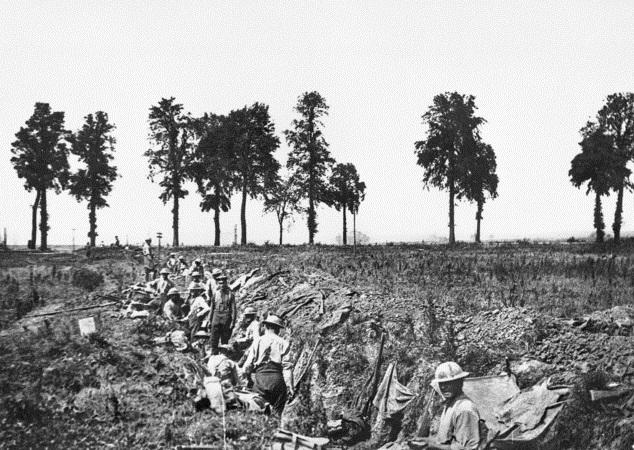 Last month marked the centenary of the first shots of the Great War. This month, last Saturday to be precise, marks the centenary of the inauguration of a crucial element in the way that Australia records its role in war. On 20 September 1914 the Minister for Defence in the newly elected Fisher Government, Senator George Pearce, met the Sydney Morning Herald journalist Charles Bean, who had been elected by the Australian Journalists’ Association as the official war correspondent. As John Connor records in his study of Australia’s longest-serving Defence Minister, Pearce told Bean that he should not only file newspaper reports but also, after the war, write a history of Australia’s part, which would become ‘a permanent record for libraries, schools, and the nation generally’.
Last month marked the centenary of the first shots of the Great War. This month, last Saturday to be precise, marks the centenary of the inauguration of a crucial element in the way that Australia records its role in war. On 20 September 1914 the Minister for Defence in the newly elected Fisher Government, Senator George Pearce, met the Sydney Morning Herald journalist Charles Bean, who had been elected by the Australian Journalists’ Association as the official war correspondent. As John Connor records in his study of Australia’s longest-serving Defence Minister, Pearce told Bean that he should not only file newspaper reports but also, after the war, write a history of Australia’s part, which would become ‘a permanent record for libraries, schools, and the nation generally’.
Bean did just that. He himself wrote six volumes, and oversaw the preparation of another six, of the Official History of Australia in the 1914-18 War. Those twelve volumes, with (as an early reviewer noted) their covers the colour of dried blood, took their place on bookshelves in thousands of Australian homes. Many Australian families took particular pride in a passage where Bean gave a detailed account of a particular engagement, with a footnote giving personal details of a named soldier. Bean initially thought he would complete his task within five years: in fact it took more than two decades.
Since that first conversation between Pearce and Bean, our understanding of Australia’s role in wars, and of war’s role in almost every aspect of Australian life, has been underpinned by four more series of official histories. In 1943, while Bean was still at work on his history, the War Cabinet appointed another journalist, Gavin Long, to take charge of what became The Official History of Australia in the 1939-45 War. That eventually comprised 22 volumes, of which Long himself wrote three.
In the 1970s Robert O’Neill, now the doyen of Australian strategists and military historians but then a young scholar who had served in an infantry battalion in Vietnam, was commissioned to write what became a two-volume official history of Australia in the Korean war. One was the first such volume to be devoted to strategy and diplomacy. It remains the most authoritative account of the origins of the ANZUS Treaty, while the other covers the combat operations of all three services.
As O’Neill was completing his task, I was appointed to prepare an official history that was originally designated as covering the Malayan Emergency and the Vietnam War. After some years, I succeeded in having the Indonesian Confrontation of Malaysia in the mid-1960s included, and the project was rechristened The Official History of Australia’s Involvement in Southeast Asian Conflicts 1948-75. That has now been completed in nine volumes, of which I wrote the two on strategy, politics and diplomacy.
The fifth series is currently in preparation. The prodigious and prolific David Horner is in charge of a multi-volume official history of Australia’s involvement in peacekeeping, humanitarian and post-Cold War operations. The first of those has been published, and a second is imminent.
I’m clearly a partial witness, but I believe there’s ample evidence that all five series have made major contributions to Australia’s understanding of an important part of its history. Of course, interpretations and emphases have been challenged, but the level of debate has been raised considerably by the information and assessments included in these multi-volume histories. Many of the books and their respective authors have won prizes and accolades in Australia and abroad. Earlier this year a reviewer in The Weekend Australian described the Southeast Asian conflicts series as ‘a minor national treasure’.
That has been possible because governments of all persuasions have given the five official historians, and their respective teams of writers and researchers, access to all relevant government records, together with an assurance that they would not be subjected to political or official censorship. The only exclusions have been on carefully-defined security grounds, essentially other governments’ secrets and information relating to ‘the intelligence-gathering process’. My predecessors and I have all testified that those caveats were not interpreted improperly and did not significantly constrain what we wished to write. It’s a record of which governments of all political persuasions, and the nation as a whole, can be proud.
As that tradition reaches its centenary, however, its future’s a little uncertain. More than three years have passed since David Horner, in the preface to the first of his series to be published, said that he hoped that the East Timor, Afghanistan and Iraq (2003) commitments would be added to his brief. No decision to that effect has yet emerged. Moreover, Horner has publicly noted that some departmental officials do not seem to understand the freedom from censorship under which official war historians have always operated.
There’d be no better way for the government to mark this centenary—falling in the week of another commitment—than an announcement that the East Timor, Afghanistan and Iraq commitments are to be incorporated into the official war history tradition, under the same terms as Australia’s other conflicts since 1914.
Peter Edwards is the Official Historian of Australia’s involvement in Southeast Asian Conflicts 1948-75. Image courtesy of the Australian War Memorial.